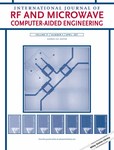Characteristic mode analysis of harmonic suppressed stepped impedance strip dipole antenna
Funding information: University Grants Commission, Grant/Award Number: F.15-6(DEC.2014)/2015 (NET)
Abstract
This paper presents the characteristic mode analysis of the harmonic suppressed stepped impedance strip dipole antenna. The proposed antenna is resonating at 2.4 GHz with the excellent suppression of higher harmonics. Characteristic mode analysis is effectively utilized to identify the radiating modes of the antenna. The prototype has been designed and fabricated on a single-sided FR4 substrate of dielectric constant 4.4 and loss tangent 0.025. The antenna has an overall dimension of 0.36 λ0 × 0.096 λ0 × 0.0128 λ0, and the prototype is experimentally studied and validated with simulations. The impedance bandwidth of the antenna is from 2.18 to 2.77 GHz (24.58%), which covers WiMAX (2.5-2.7 GHz), WLAN (2.4-2.48 GHz), Bluetooth (2.4-2.48 GHz), and LTE (2.18-2.69 GHz). The measured peak gain and peak efficiency of the antenna are 1.75 dBi and 95%, respectively.
Open Research
DATA AVAILABILITY STATEMENT
Data sharing not applicable - no new data generated




